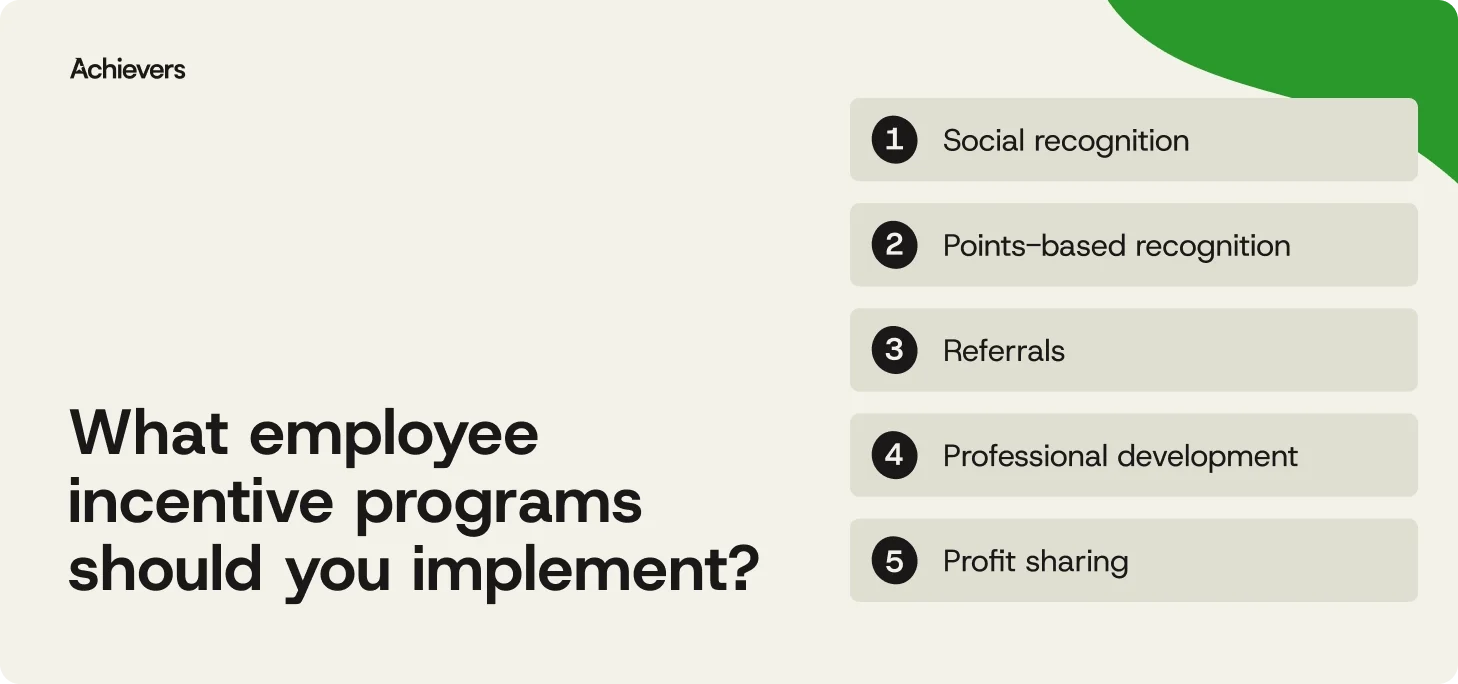Table of contents
Employee disengagement is a growing concern, and let’s be honest — without the right incentives, it’s a recipe for high turnover, low productivity, and a dip in your bottom line. In fact, unhappy employees are costing the U.S. a whopping $1.9 billion annually. Yikes. That’s where well-designed employee incentive programs come in.
As leaders and HR professionals, it’s on you to keep your teams engaged and motivated. To do that, you need to grasp the current state of recognition, understand its impact, and — most importantly — know how to reward and incentivize your team in a way that actually works. Let’s dive into 25 employee incentive programs that can help you do just that.
25 employee incentive programs to improve engagement
Employee incentive programs have tremendous benefits, but where should you start? Here are some incentive examples that have been proven to engage and motivate employees over the long haul:

1. Social recognition programs
Social recognition gives employees the spotlight they deserve, boosting their confidence and encouraging positive behavior. It’s a great way to boost engagement — employees recognized in this way are 3.7 times more engaged and 55% less likely to leave. Basically, it’s a win-win for everyone.
2. Points-based recognition programs
With points-based recognition, employees earn rewards based on their performance, and they can spend those points however they like from a reward marketplace. It’s a great way to keep morale high and performance even higher — 61% of employees feel a stronger sense of belonging, and 60% feel more recognized. It’s a system that just keeps giving.
3. Referral programs
Referral programs make employees your best recruiters. Those who refer candidates tend to stick around 46% longer than other hires. With tiered rewards and integration into your recognition program, you’ll not only fill your pipeline with top talent, but also keep your team excited about bringing in the best.
4. Professional development programs
When you invest in employees’ growth, they’ll return the favor with productivity and loyalty. Companies that offer training to engaged employees see 17% higher productivity and 21% more profitability. It’s a win for the business and the employees — they grow, you grow, everyone wins.
5. Profit sharing programs
Profit sharing is like saying, “You helped make this happen.” Employees who share in the company’s success become more engaged and loyal. And if profit sharing isn’t on the table, 401(k) matches work just as well. Either way, it’s a gesture that keeps employees motivated and invested in the company’s future.
6. Health and wellness programs
Wellness programs are more than just free yoga classes — they’re about preventing burnout and keeping your team feeling their best. With 80% of employees reporting burnout, offering wellness challenges, standing desks, or fitness incentives shows employees you care about their well-being, not just their productivity.
7. Tuition reimbursement programs
Investing in education is a great way to invest in the future. Tuition reimbursement not only boosts retention but also ensures employees feel more prepared for their work. 84% of employees feel more prepared for their roles after getting education support, so it’s a benefit that pays off big time.
8. Bonuses and raises
Bonuses and raises are a clear and direct way to show appreciation. 52% of workers say they feel more valued when they get an annual bonus. Make sure the goals are clear and attainable, and you’ll have employees motivated and striving for excellence (without the rivalry).
9. Fun gifts
Everyone loves a surprise gift. Whether it’s a shiny gadget or a fun experience, gifts show employees they’re appreciated. Make them personal or give employees the power to choose (gift cards are a hit). It’s a small gesture that makes a big impact on morale.
10. Additional time off
Nothing says “we appreciate you” like extra vacation time. Offering paid time off as a reward for hitting goals not only boosts satisfaction but also keeps burnout at bay. And let’s be honest — who doesn’t love a little extra time to recharge?
11. Choice of projects
Let employees pick projects that match their passions or strengths. It’s a great way to keep them motivated, engaged, and showing off their best work. It’s all about giving them ownership and the freedom to shine.
12. Employee benefits program
A great benefits package goes beyond salary — it shows employees you care about their health and happiness. Comprehensive benefits like health insurance, paid time off, and more keep employees feeling secure and engaged, building loyalty while attracting top talent.
13. Human resources development
HR development is all about long-term growth. Companies that focus on enhancing employees’ skills see a huge increase in engagement and satisfaction. Investing in talent development shows your team that you’re committed to their growth, and that’s a big motivator for top performers.
14. Performance management programs
Performance management programs align individual goals with the company’s success, making everyone feel part of the bigger picture. But only 2 in 10 employees feel their performance is managed in a way that motivates them to excel, and just 14% say their reviews inspire improvement. It’s time to make performance feedback more exciting and motivating for employees to reach their full potential.
15. Travel incentives
Travel incentives offer fully paid trips for hitting targets. 53% of senior leaders call it a “must-have” and 48% see it as a strategic differentiator. Rewarding with travel boosts morale, performance, and loyalty by turning hard work into unforgettable experiences.
16. Commission programs
Commission programs directly link effort to reward. They’re a great way to motivate sales teams and align their success with the company’s growth. It’s a system that pays off — after all, $200 billion is spent on sales compensation in the U.S. every year.
17. Flextime programs
Flextime is a powerful tool for retention, with 80% of employees saying they’d stick around longer with flexible hours. Allowing employees to set their schedules shows trust and helps them balance their personal and professional lives, which boosts engagement and keeps morale high.
18. Employee resource groups (ERGs)
According to AWI data, employees in ERGs are 34% more committed, and 20% less likely to job hunt. ERGs create belonging, boost collaboration, and enhance retention. They’re also great for attracting top talent, showing employees their voices are heard and valued.
19. Customized learning stipends
Learning stipends let employees invest in their own growth. Offering funds for courses or conferences shows you care about their personal development. It’s a great way to motivate employees to keep learning, and it’s a win for both their career and your business.
20. Sabbatical leave rewards
Sabbaticals allow employees to recharge, come back fresh, and tackle new challenges with renewed energy. It’s a great way to reward loyalty, prevent burnout, and keep top talent happy and engaged. Sometimes, a little time off is just what an employee needs to bring their best self to work.
21. Green commuting incentives
Encouraging eco-friendly commuting options, like biking or public transit, not only helps the planet but also shows employees you care about their well-being. These incentives are a great way to promote sustainability, reduce commuting costs, and improve health, all while aligning with your company’s values.
22. Wellness challenges with rewards
Wellness challenges turn healthy habits into fun competitions. Whether it’s step goals, fitness milestones, or nutrition challenges, rewards keep employees engaged in their well-being. It’s a fun way to foster team spirit while encouraging everyone to stay healthy and motivated.
23. Family-oriented perks
Family perks, like scholarships or allowances for family outings, show employees you care about their personal lives. Supporting family life increases work satisfaction and performance, making your company more attractive to top talent and increasing employee loyalty.
24. Recognition through peer awards
Peer awards foster collaboration and appreciation, empowering employees to recognize each other’s contributions. This creates a positive, inclusive workplace where recognition is shared at all levels, boosting morale and motivating employees to go above and beyond.
25. Innovation incentives
Innovation incentives reward creative ideas that improve business outcomes. Recognizing and implementing these ideas with bonuses or leadership opportunities encourages a culture of creativity, helping employees feel empowered to drive change and continuous improvement within the company.
Best practices for employee incentive programs
After you choose the right employee incentive programs for your company, you need to put them into practice. Here are some best practices that can help you implement impactful incentive programs:
- Make your program inclusive: To keep everyone in the loop, offer a variety of incentives that appeal to all teams. Don’t forget to recognize both program leaders and participants. A user-friendly platform will ensure employees feel involved, valued, and ready to reap the rewards.
- Promote your incentive programs: Spread the word. Build a communications plan that raises awareness and keeps employees engaged. From fun posters to email campaigns, let your staff know what’s up. And make sure new hires get the scoop from day one to keep them in the loop.
- Have leaders show the way: Leaders aren’t just managers; they’re incentive program cheerleaders. When they lead by example, it’s easier for employees to jump in. Training leaders on how to engage with incentives ensures a ripple effect throughout the organization.
- Personalize your incentives: One size fits no one. Use AI and feedback to tailor rewards to what motivates your employees. Whether it’s HR hackathons or just listening, personalizing incentives makes sure your team feels seen and appreciated.
- Ask for feedback: Don’t guess what employees want — ask. Use pulse surveys, feedback platforms, and good old-fashioned conversations to gather insights. Listening shows employees that their voices matter and helps refine your programs to keep them relevant and effective.
The value of employee incentive programs
If you want to boost employee morale and keep engagement high, you’ll need more than just a friendly email or a pat on the back. That’s where effective incentive programs come in. In fact, U.S. businesses spend a hefty $176 billion on incentives, recognition, rewards, and even incentive travel.
So, why are incentive programs so powerful? They tap into basic human behavior. The magic lies in frequent rewards, which link tasks with tangible goals, making employees more motivated to hit targets. Companies that embrace incentive programs see a higher success rate in reaching their goals — and let’s be honest, who doesn’t like a little extra motivation?
But here’s the kicker: moving beyond those old-school, annual years of service awards and making incentives a daily part of your culture can truly transform performance. When employees feel recognized, they perform better and stick around longer. Plus, businesses that offer tangible sales incentives often see impressive revenue growth, and professionals who are happy with their benefits are more likely to be happy with their jobs. Everyone wins!
Make your incentives meaningful
Recognition isn’t just about a pat on the back — it’s how you know your work matters. The best companies recognize the right behaviors, and it gives them a competitive edge. That’s where Achievers comes in. We turn recognition into real results with tools backed by science and psychology.
With double the engagement of any other platform, Achievers helps you shape your workforce and boost performance. More rewards for every dollar spent, 5x the engagement, and a platform that fits seamlessly into your workflow.
Great businesses recognize with Achievers because they know shaping behavior means shaping success.



